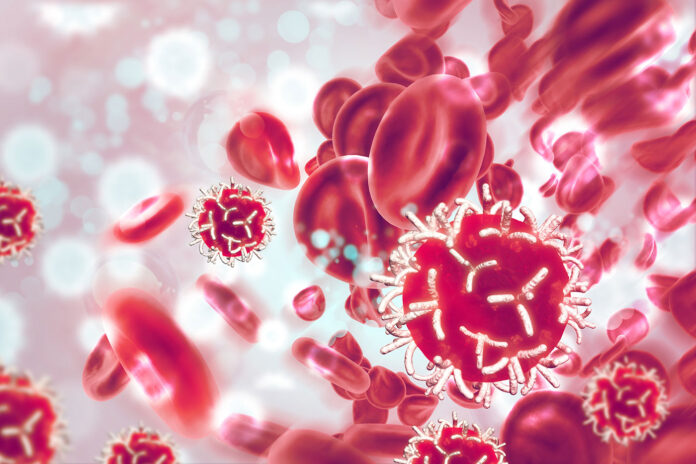
The use of liquid biopsies, particularly as a non-invasive diagnostic tool to detect cancer, has accelerated over the past ten years. While its applications in pathologies such as lung cancer or as a tool for detecting minimal residual disease (MRD) are well-documented, researchers continue to broaden its use in hard-to-detect cancers with historically poor outcomes and applicability to tissue samples rather than blood. Some are even working on ways to preserve the amount of tumor DNA circulating in the body for more detailed analysis.
Here, we present the results of three such research efforts that are pushing the boundaries of liquid biopsy, with significant implications for improving clinical care and cancer detection.
Early-stage ovarian cancer detection
The most lethal form of ovarian cancer is high-grade serous ovarian carcinoma (HGSOC). The most common form of epithelial ovarian cancer (EOC), HGSOC has very low survival rates because it usually presents at an advanced stage. When diagnosed at a late stage, the five-year survival rate is only around 40%.
In addition, even when a pelvic mass suspected of being HGSOC is detected via imaging, clinicians have no definitive method of determining whether the mass is benign or cancerous as collecting a tissue biopsy is typically not an option before surgery.
Now, however, researchers from the University of Southern California (USC) Norris Comprehensive Cancer Center and the Keck School of Medicine of USC believe that they have developed a novel liquid biopsy test leveraging cell-free DNA (cfDNA) to sniff out aberrant DNA methylation, which is indicative of ovarian cancer.

associate professor of Translational Genomics at Keck
Leading this research at USC is Bodour Salhia, PhD, an associate professor of translational genomics at Keck. To date, most liquid biopsy assays have looked for known cancer mutations, but Salhia’s interest in the early detection of ovarian cancer revealed DNA methylation to be a better option.
“I realized that while analysis for mutations was a great advancement in the field, it wasn’t going to get us to early detection, because it wasn’t specific enough for a specific cancer type,” Salhia said. “A KRAS mutation could come from anywhere, but a methylation profile might have more tissue specificity and allow you to really narrow down a specific organ type of interest.”
Salhia first became intrigued by the possibilities of developing methylation biomarkers during her earlier work in breast cancer but chose HGSOC for her current work as it was a highly lethal tumor type that lacked reliable early detection methods.
Although the test she developed, called OvaPrint, has potential as an early detection tool, more research is warranted to validate it. But its first use case, detailed in a study published last year in Clinical Cancer Research, is as a test to help clinicians accurately classify identified pelvic masses as either benign or HGSOC.

associate professor of obstetrics and gynecology and division chief of gynecologic oncology
Keck School of Medicine
Having the ability to discern which pelvic masses are HGSOC or benign would usher a new paradigm of appropriate care for women, said Lynda Diane Roman, MD, an associate professor of obstetrics and gynecology and division chief of gynecologic oncology at the Keck School of Medicine, who is also a co-author of the study. Currently, barring very few circumstances, a pelvic mass is characterized through guesswork and the difference in treatment between a benign mass and a cancerous one can significant affect patient outcomes.
“Eighty percent to 90% of the time, with a pelvic mass, we don’t know which it is,” says Roman. “There have been numerous attempts to know this, but the bottom line is you don’t know. The big issue is if you can predict with a high level of certainty that you are dealing with mass that is ovarian cancer, it totally changes your operative approach.”
The difference in approach starts with who is doing the resection. If the mass is a known tumor, then the surgery is more appropriately performed by an oncologic surgeon as complete removal of the tumor without breaches is paramount.
“The issue of whether we remove just the mass or the whole ovary—that is going to affect how we counsel the patient,” Roman stated. “And the use of minimally invasive surgery versus open surgery to remove the mass and avoid rupture are the major things you would need to know beforehand.”
For this research, Salhia’s team compared a total of 372 samples, obtained from patients who had been diagnosed with ovarian cancer in its early stages and from patients with normal ovaries or benign tumors. The normal samples included not just tissue from ovaries, but also from the fallopian tubes.
“We compared the high grade serous ovarian cancer tissue with tissue from normal fallopian tubes, or normal ovary, and that was a unique aspect of our studies,” said Salhia. “We showed [HGSOC] is likely originating from the fallopian tube. Most people believe that ovarian cancer arises from the fallopian tube, so it was important to include the fallopian tube tissue.”
The development of OvaPrint used features that were revealed by RNA bisulfate sequencing to discern the methylation patterns that differentiated normal tissue from cancerous tissue. The resulting assay demonstrated a positive predictive value (PPV) of 0.95 and a negative predictive value (NPV) of 0.88, surpassing other commercial tests.
The results, the researchers noted, indicate “that a positive test result will accurately identify patients with HGSOC, minimizing false positives which would lead to unwanted surgical interventions by gynecologic oncologists. The high NPV demonstrates that OvaPrint can accurately identify patients who are truly negative, minimizing false negatives which would leave lethal gynecologic malignancies undetected.”
Salhia added that OvaPrint could mark an advance in the diagnosis and treatment of ovarian cancer by delineating the unique properties of HGSOC from other forms of epithelial ovarian cancer and encourage a move away from grouping all EOC cancers in one bucket. To that end, her ongoing research will aim to develop markers for other EOC cancers such as endometrioid, clear cell, mucinous, and low-grade serous ovarian cancer, which can be incorporated into future versions of OvaPrint.
Leveraging lymphatic fluid in head and neck cancers
It is often said that one man’s trash is another’s treasure. When it comes to finding more ways to determine the most effective treatments for head and neck cancers, José Zevallos, MD, a professor and chairman of the department of otolaryngology at the University of Pittsburgh School of Medicine, brings this cliché to life.

The “trash” in Zevallos’ world is the lymphatic fluid that is drained from patients after undergoing surgery for head and neck cancer, which is usually discarded. These days, it also serves as a new tissue sample for liquid biopsy that can be collected and analyzed shortly after surgery to determine which adjuvant therapy, if any, is needed by a patient post-tumor resection.
A physician who also runs his own research lab, Zevallos said that the insight to leverage lymphatic fluid drained from a patient’s surgery site for liquid biopsy came because of these dual roles.
“If you’re a clinician alone, without a research background, you may not have this insight, even though you deal with drains and fluid every day,” he said. “If you’re in the lab alone, you don’t know what a surgical drain does or really what it is. It was a marriage of both that led to this insight.”
Using post-operative lymph, Zevallos and his research partner Aadel Chaudhuri, MD, PhD, assistant professor of radiation oncology at the Washington University School of Medicine, have developed a test to detect human papillomavirus (HPV) DNA in the lymph. Their claim is that this test is a more accurate way of gauging adjuvant therapy for patients with HPV-positive oropharyngeal squamous cell carcinoma (OPSCC).
Currently, surgeons determine which adjuvant therapy is necessary, radiation or chemoradiation, based on pathology features. If there are multiple positive lymph nodes or pairing neural invasions, then a patient receives radiation alone; if the cancer has spread outside the capsule of a lymph node, then a patient receives a combination of chemotherapy and radiation. This visual inspection of the lymph nodes and surgical margins for remaining cancer cells is considered the gold standard for determining adjuvant therapy. Unfortunately, up to 30% of patients with HPV-positive OPSCC experience a recurrence of the cancer, which is seeded by occult, or unknown primary, tumor cells. Zevallos’ work with the new lymph liquid biopsy aims to reduce that number by finding hard-to-detect residual disease.
“There are cases where we treat based on the pathology where the cancer still recurs, and there are also cases, especially with HPV-positive throat cancer, where we are probably over-treating patients,” Zevallos said. “The way we envision this working is we still rely on pathology, but in cases where you are not sure whether to treat one way or another, the test will provide an objective view to help decide if adjuvant therapy is needed and, if so, which one.”

In research published in December 2023, Zevallos, Chaudhuri, and their team prospectively collected lymph from 106 patients with HPV-positive OPSCC along with 67 matched plasma samples 24 hours after surgery. They then used PCR and next-generation sequencing to quantify cancer-associated cell-free HPV (cf-HPV) and tumor-informed variants in both the lymph and plasma samples. Results showed successful cf-HPV detection in 78% of the lymph samples compared with just a 12% detection rate from the plasma samples. Importantly, the cf-HPV levels in lymph were thousands of times higher than in the plasma samples.
Using these data, the team then compared the lymph cf-HPV and variants with the tumor-node-metastasis stage, extranodal extension—both widely used criteria for the therapeutic management of patients with head and neck tumors—and composite definitions of high-risk pathology. The model accurately identified low- and high-risk patients, with cf-HPV of lymphatic fluid proving a vital source of data for their model.
Since the original publication, Zevallos and team have continued to refine their approach and apply it to HPV-negative cancers. In a poster the team will present at this year’s AACR Annual Conference, they take a tumor-informed targeted sequencing approach to identify unique variants and variant allele fractions, which also showed that using lymph samples was more prognostic of disease recurrence.
“You can imagine a haystack of blood where there is also normal cfDNA and you are finding a tiny variant in that massive pool of blood,” Zevallos noted. “But with lymph fluid, it is a highly concentrated proximal biofluid. The reason we think it is much more prognostic is that HPV-negative cancers recur almost exclusively regionally. They don’t recur distally. It just stands to reason that we would detect cancer in the neck before we do in plasma.”
Boosting circulating tumor (ctDNA) levels in plasma
From the outset, the development and utility of liquid biopsies have been hampered by the scarcity of ctDNA in a standard blood draw. The reasons for this scarcity are mechanisms in the body that work to clean the blood, like uptake by liver-resident macrophages and degradation by circulating nucleases.

To date, efforts to overcome this scarcity have focused on improving ex vivo detection and analysis, but with very little effect. “You can only push sequencing technology so far,” noted Viktor Adalsteinsson, PhD, director of the Gerstner Center for Cancer Diagnostics at the Broad Institute of MIT and Harvard. “If there’s not tumor DNA in a blood tube, no amount of sequencing will be able to detect it.”
But what if methods that could temporarily interfere with the clearance of ctDNA were developed, preserving levels that are more than ten times greater than found in current blood draws? That’s exactly the approach taken by Adalsteinsson in his lab, in collaboration with the Broad Institute labs of Sangeeta Bhatia, MD, PhD, and J. Christopher Love, PhD.
In a groundbreaking January publication in Science, Adalsteinsson and colleagues showed that the intravenous deployment of two priming agents—nanoparticles that act on the cells responsible for cfDNA clearance and DNA-binding monoclonal antibodies that protect cfDNA—transiently preserved ctDNA levels at more than sixty times the levels seen in normal blood draws in some instances.
“Our teams have been working together for many years on priming agents,” Adalsteinsson said. “What inspired us to pursue antibodies and nanoparticles for this application was their well-established moieties in medicine and well-established development pathways.”
To engineer these agents, the researchers had ample resources to call on to help ensure their safety. In the case of the nanoparticle, the team based its design on FDA-approved nanobody formulations, while the antibody was engineered to create one with a mutation that silences the FC region, a part of the antibody that interacts with cell surface receptors, and thus prevent activation of the immune system.
In mouse studies, the team saw no adverse events related to either agent and improved the sensitivity of detecting cancer by liquid biopsy in mice with low tumor burden from below 10% to more than 75%. ctDNA levels returned to baseline in the mouse models within 24 hours of introducing the agents.
“The ability to get peak activity of these agents within a couple of hours, followed by their rapid clearance, means that someone could go to their doctor’s office, receive an agent like this, and then give their blood for the test itself, all within one visit,” Love said. “This feature bodes well for the potential to translate this concept into clinical use.”
The potential improvements in ctDNA analysis by increasing its population in the blood are many. Adalsteinsson noted that current efforts to find disease recurrence have focused on MRD detection. “But increasingly, I think molecular profiling is going to matter,” he said. “Our hope would be that using a primer, we could put more of the tumor genome in the blood to determine its molecular profile to inform which therapies may benefit the patient most.”
With this highly encouraging early data in hand, the MIT team is now looking to further optimize the nanoparticle and antibody. This will potentially lower the dosing amount needed to achieve the same level of performance and reduce the amount of time between intravenous delivery of the agent and the subsequent blood draw. Based on their current development timeline, Adalsteinsson said the goal is to begin in-human testing of these agents within two years.
Chris Anderson, a Maine native, has been a B2B editor for more than 25 years. He was the founding editor of Security Systems News and Drug Discovery News, and led the print launch and expanded coverage as editor in chief of Clinical OMICs, now named Inside Precision Medicine.













